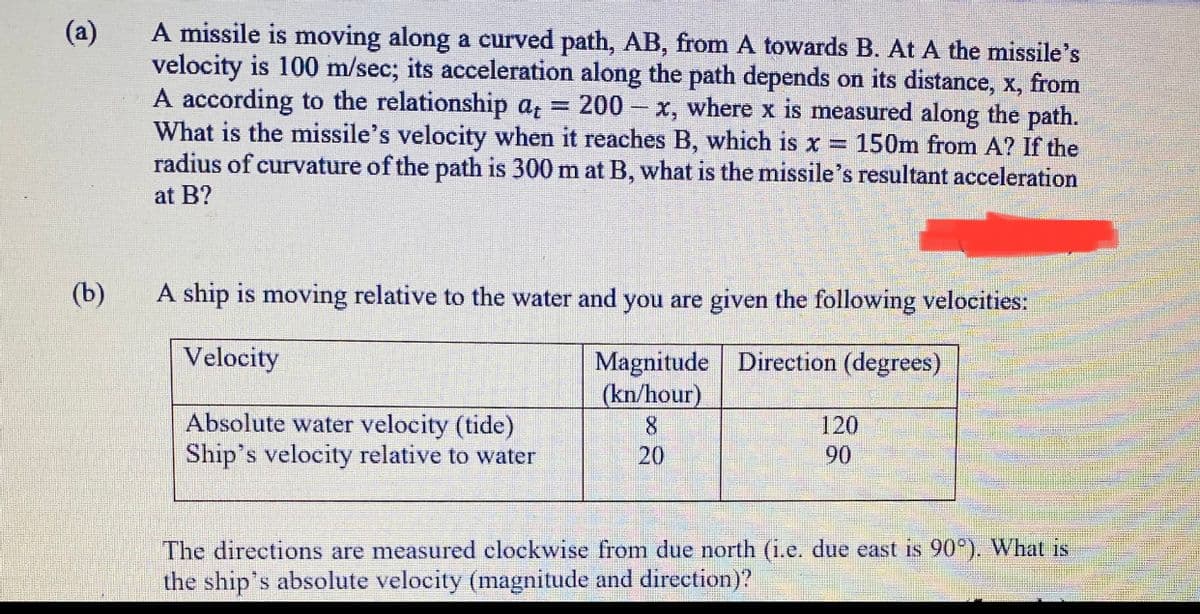(a) A missile is moving along a curved path, AB, from A towards B. At A the missile's velocity is 100 m/sec; its acceleration along the path depends on its distance, x, from A according to the relationship az = 200 – x, where x is measured along the path. What is the missile's velocity when it reaches B, which is x = 150m from A? If the radius of curvature of the path is 300 m at B, what is the missile's resultant acceleration at B?
(a) A missile is moving along a curved path, AB, from A towards B. At A the missile's velocity is 100 m/sec; its acceleration along the path depends on its distance, x, from A according to the relationship az = 200 – x, where x is measured along the path. What is the missile's velocity when it reaches B, which is x = 150m from A? If the radius of curvature of the path is 300 m at B, what is the missile's resultant acceleration at B?
Elements Of Electromagnetics
7th Edition
ISBN:9780190698614
Author:Sadiku, Matthew N. O.
Publisher:Sadiku, Matthew N. O.
ChapterMA: Math Assessment
Section: Chapter Questions
Problem 1.1MA
Related questions
Question

Transcribed Image Text:A missile is moving along a curved path, AB, from A towards B. At A the missile's
velocity is 100 m/sec; its acceleration along the path depends on its distance, x, from
A according to the relationship a,
What is the missile's velocity when it reaches B, which is x = 150m from A? If the
radius of curvature of the path is 300 m at B, what is the missile's resultant acceleration
(a)
200 x, where x is measured along the path.
at B?
(b)
A ship is moving relative to the water and you are given the following velocities:
Velocity
Magnitude Direction (degrees)
(kn/hour)
Absolute water velocity (tide)
Ship's velocity relative to water
120
20
90
The directions are measured clockwise from due north (i.e. due east is 90°). What is
the ship's absolute velocity (magnitude and direction)?
Expert Solution
This question has been solved!
Explore an expertly crafted, step-by-step solution for a thorough understanding of key concepts.
Step by step
Solved in 3 steps with 5 images

Knowledge Booster
Learn more about
Need a deep-dive on the concept behind this application? Look no further. Learn more about this topic, mechanical-engineering and related others by exploring similar questions and additional content below.Recommended textbooks for you

Elements Of Electromagnetics
Mechanical Engineering
ISBN:
9780190698614
Author:
Sadiku, Matthew N. O.
Publisher:
Oxford University Press

Mechanics of Materials (10th Edition)
Mechanical Engineering
ISBN:
9780134319650
Author:
Russell C. Hibbeler
Publisher:
PEARSON

Thermodynamics: An Engineering Approach
Mechanical Engineering
ISBN:
9781259822674
Author:
Yunus A. Cengel Dr., Michael A. Boles
Publisher:
McGraw-Hill Education

Elements Of Electromagnetics
Mechanical Engineering
ISBN:
9780190698614
Author:
Sadiku, Matthew N. O.
Publisher:
Oxford University Press

Mechanics of Materials (10th Edition)
Mechanical Engineering
ISBN:
9780134319650
Author:
Russell C. Hibbeler
Publisher:
PEARSON

Thermodynamics: An Engineering Approach
Mechanical Engineering
ISBN:
9781259822674
Author:
Yunus A. Cengel Dr., Michael A. Boles
Publisher:
McGraw-Hill Education

Control Systems Engineering
Mechanical Engineering
ISBN:
9781118170519
Author:
Norman S. Nise
Publisher:
WILEY

Mechanics of Materials (MindTap Course List)
Mechanical Engineering
ISBN:
9781337093347
Author:
Barry J. Goodno, James M. Gere
Publisher:
Cengage Learning

Engineering Mechanics: Statics
Mechanical Engineering
ISBN:
9781118807330
Author:
James L. Meriam, L. G. Kraige, J. N. Bolton
Publisher:
WILEY